A group of students from nine countries and majoring in Korean studies is visiting Korea for a special program, offered by Korean experts in the culture and arts sectors. It is the 2014 Museum Network Fellowship program hosted by the National Museum of Korea (NMK). Marking the third anniversary this year, the program began on June 30 and runs for two weeks.
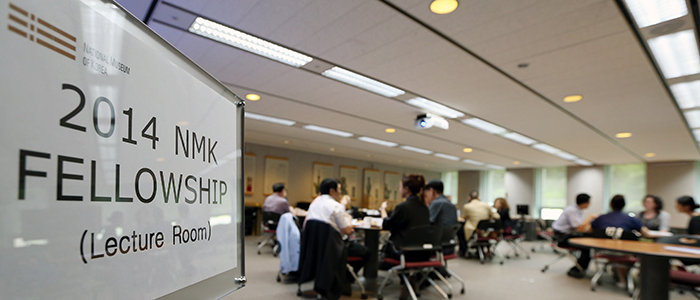

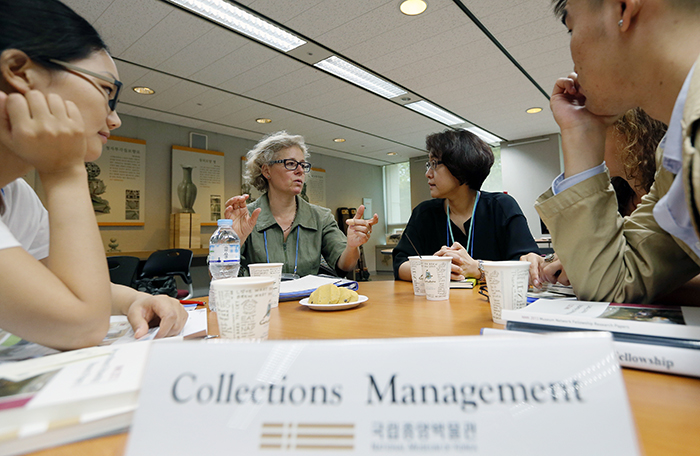
The participating students are being exposed to a feast of Korean history and culture - contemporary arts, history, archeology, Buddhist crafts and sculpture, architecture, painting and pottery. In addition to the lectures on various topics, the students will be given opportunities to explore major museums and galleries - the National Museum of Korea, Gyeongju National Museum, the National Museum of Modern and Contemporary Art in Deoksugung Palace - as well as historical sites such as Bulsuksa Temple and Seokguram Grotto in Gyeongju.
The 15 students selected for this fellowship program are mostly carrying out Masters or Ph.D. courses in their own countries. Their nationalities and backgrounds are varied, as are their academic institutions. They come from Germany, Slovenia, India, Switzerland, England, Japan, America and China and study at the University of Helsinki in Finland, Waseda University in Japan, Heidelberg University in Germany, Sapienza University in Italy, Oxford University in the UK and Princeton, Yale, Colombia and UCLA in the U.S.
This fellowship program prepared by the NMK is expected to provide the next generation of researchers easier and better access to Korean culture. Korea.net sat down with three next generation researchers and heard about their impressions of Korea: Andrew Logie, who is 32, from the UK, and in the 4th year of a Ph.D. at the Faculty of East Asian Studies at Helsinki University in Finland. Alice Sophia Powers, 29, and in the 2nd year of a Ph.D. in modern and contemporary Indian arts at UCLA. And Ornella De Nigris, 32, studying Chinese contemporary arts in Sapienza University in Rome, Italy.
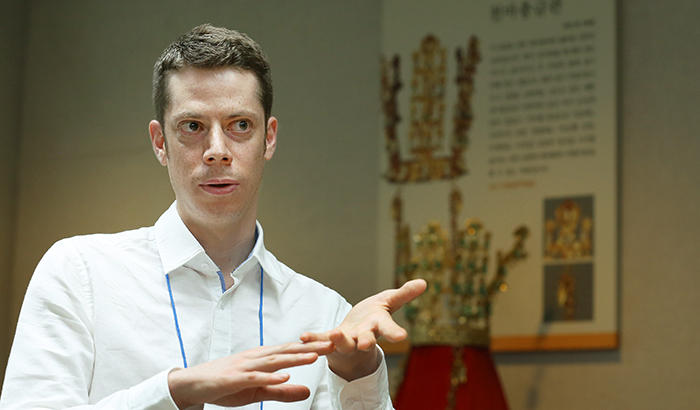
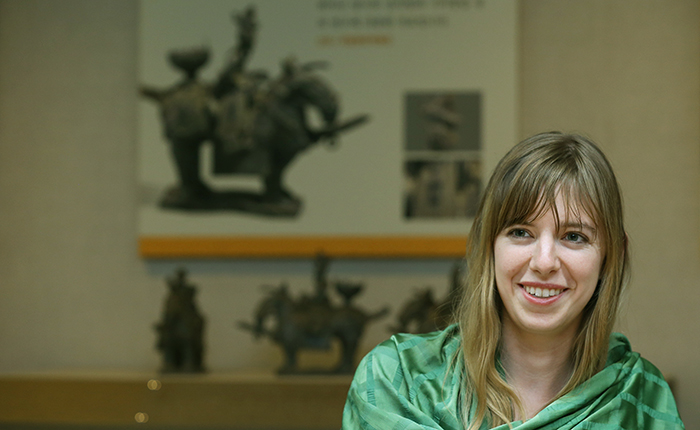
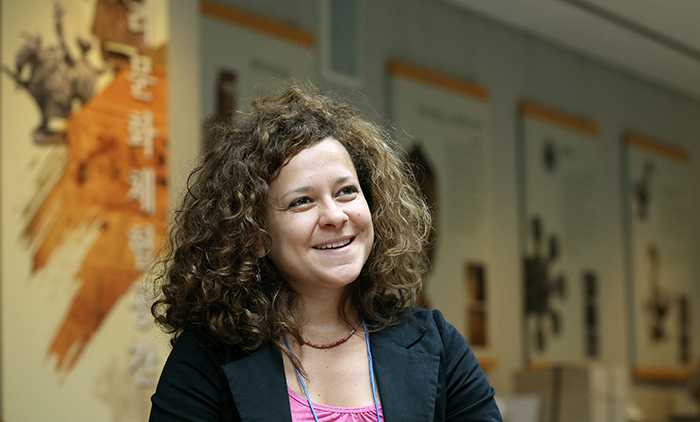
Which part of Korean culture attracted you the most?
- Andrew: I have always had an interest in East Asian history. I took an interest in Chinese and Japanese history first and then it naturally shifted to Korea. My main focus is on historiography, about how the nation's history developed from the 18th to the 20th century.
During the 18th century in Korea, Silhak (實學), a type of social reform movement pursuing practical studies arose, and a new group of scholars called Bukhak (北學派) emerged to stress the importance of northern learning. I pay special attention to two scholars from the late Joseon Dynasty, Yu Deuk-gong (柳得恭, 1748-1807), the author of Balhaego (渤海考): a history book about the Balhae civilization, and Lee Jong-hui (李種徽, 1731-1797), who authored Dongsa (東史), East Asian history. I am now researching how the scholarly flow continued until the 20th century.
- Alice: My focus is on Indian contemporary arts, and my secondary focus is on East Asian painting. Like Andrew, at first I only knew about Chinese and Japanese culture. When I first encountered Korean painting, I was so surprised at its beauty. Personally, I am very interested in the artist Choi Buk (崔北, 1712-1760) from the Joseon Dynasty. How he did his work seemed like a performance piece. It is not just what you see on the painting. It's his whole identity that is revealed. I see him as an unusual figure who had the capability to express the dynamism of his personality in the painting.
- Ornella: My interest developed from Chinese language to East Asian art history. I'm doing my Ph.D. in contemporary arts museum with a focus on how institutions engage in exchanging art pieces. In the middle of that, I developed my interest in Korea, and part of my focus is on the Gwangju Biennale. I'm researching how big events such as Biennale and Triennale are giving influence across East Asian countries.
How about your impression of Korea?
- Andrew: I have made short visits to Korea a number of times. I made efforts to learn about Korean language and history. Based on my past experience and studies, one of the main features of Korean culture and history has been two traditions happening at the same time. This was prominent in the Joseon Dynasty that clearly separated the higher class of yangban from the lower class of pyeongmin. Two traditions were separated in terms of writing system too. The public used hangeul, the native language system, while the higher class used classical Chinese characters. Not only these traditional elements, there are many other influences of Chinese culture still remaining in modern culture.
My knowledge of classic Chinese characters is not very deep. I have been trying to read ancient historical books such as Samgukyusa and Jewangungi. I read the original version in Chinese first, followed by the Korean translation to check if my understanding is correct. Also, the Annals of the Joseon Dynasty made available online through the internet is very useful and helpful. It is good to utilize the online integrated service provided at www.koreanhistory.or.kr
Please tell us about your future plan.
- Andrew: As I mentioned before, I found Yu Deuk-gong very interesting. He was a historian and a romantic poet at the same time. Lots of his poetry was about travelling, appreciating nature, and the historical scenes he imagined. He was also reportedly interested in archeology. If you read his book you will know that he had the personality and interest in modern archeology. Yu is part of my study and I will continue in that direction.
- Alice: I plan to shift my focus from the paintings of the Joseon Dynasty to more contemporary Korean arts. First of all, it is because they are more vibrant. Also, because without being fluent in Korean literature, it would be hard for me to make scholarly contributions about more ancient works.
- Ornella: My research focus is on curators' activities and institutional exchanges at the national level. These days, it is an emerging trend to hold exchanges and collaborative exhibitions with contemporary art pieces. With a main focus on this, I will study more on exchanges in the arts between Korea and Italy.
What do you expect from this fellowship program?
- Andrew: I visited here before just as a guest. But it is different this time. Being able to come to the other side of the museum, seeing what's happening and meeting expert curators are all interesting and are a fresh experience for me. Being able to see artworks in close direct hands is very important.
- Alice: I have been just excited to visit Korea and to get to know about Korean culture. If I become a professor, I will teach Korean arts. Today's experience at the museum, seeing many of these works and exchange programs, will give me ideas about how to teach it.
- Ornella: I wanted to see two possibilities from the fellowship program. The first is the possibility of collaborative exhibitions between Italy and Korea. Also, if I become a curator, whether there is a possibility for me to bring and introduce Korean arts to the Italian stage.
By Wi Tack-whan, Lee Seung-ah
Korea.net Staff Writers
whan23@korea.kr



A total of 15 Korean and East Asian Studies majors from nine countries participate in lectures and discussion sessions at the National Museum of Korea. (photos: Jeon Han)
The participating students are being exposed to a feast of Korean history and culture - contemporary arts, history, archeology, Buddhist crafts and sculpture, architecture, painting and pottery. In addition to the lectures on various topics, the students will be given opportunities to explore major museums and galleries - the National Museum of Korea, Gyeongju National Museum, the National Museum of Modern and Contemporary Art in Deoksugung Palace - as well as historical sites such as Bulsuksa Temple and Seokguram Grotto in Gyeongju.
The 15 students selected for this fellowship program are mostly carrying out Masters or Ph.D. courses in their own countries. Their nationalities and backgrounds are varied, as are their academic institutions. They come from Germany, Slovenia, India, Switzerland, England, Japan, America and China and study at the University of Helsinki in Finland, Waseda University in Japan, Heidelberg University in Germany, Sapienza University in Italy, Oxford University in the UK and Princeton, Yale, Colombia and UCLA in the U.S.
This fellowship program prepared by the NMK is expected to provide the next generation of researchers easier and better access to Korean culture. Korea.net sat down with three next generation researchers and heard about their impressions of Korea: Andrew Logie, who is 32, from the UK, and in the 4th year of a Ph.D. at the Faculty of East Asian Studies at Helsinki University in Finland. Alice Sophia Powers, 29, and in the 2nd year of a Ph.D. in modern and contemporary Indian arts at UCLA. And Ornella De Nigris, 32, studying Chinese contemporary arts in Sapienza University in Rome, Italy.



(From the top) Andrew Logie, Alice Sophia Powers, Ornella De Nigris (photos: Jeon Han)
Which part of Korean culture attracted you the most?
- Andrew: I have always had an interest in East Asian history. I took an interest in Chinese and Japanese history first and then it naturally shifted to Korea. My main focus is on historiography, about how the nation's history developed from the 18th to the 20th century.
During the 18th century in Korea, Silhak (實學), a type of social reform movement pursuing practical studies arose, and a new group of scholars called Bukhak (北學派) emerged to stress the importance of northern learning. I pay special attention to two scholars from the late Joseon Dynasty, Yu Deuk-gong (柳得恭, 1748-1807), the author of Balhaego (渤海考): a history book about the Balhae civilization, and Lee Jong-hui (李種徽, 1731-1797), who authored Dongsa (東史), East Asian history. I am now researching how the scholarly flow continued until the 20th century.
- Alice: My focus is on Indian contemporary arts, and my secondary focus is on East Asian painting. Like Andrew, at first I only knew about Chinese and Japanese culture. When I first encountered Korean painting, I was so surprised at its beauty. Personally, I am very interested in the artist Choi Buk (崔北, 1712-1760) from the Joseon Dynasty. How he did his work seemed like a performance piece. It is not just what you see on the painting. It's his whole identity that is revealed. I see him as an unusual figure who had the capability to express the dynamism of his personality in the painting.
- Ornella: My interest developed from Chinese language to East Asian art history. I'm doing my Ph.D. in contemporary arts museum with a focus on how institutions engage in exchanging art pieces. In the middle of that, I developed my interest in Korea, and part of my focus is on the Gwangju Biennale. I'm researching how big events such as Biennale and Triennale are giving influence across East Asian countries.
How about your impression of Korea?
- Andrew: I have made short visits to Korea a number of times. I made efforts to learn about Korean language and history. Based on my past experience and studies, one of the main features of Korean culture and history has been two traditions happening at the same time. This was prominent in the Joseon Dynasty that clearly separated the higher class of yangban from the lower class of pyeongmin. Two traditions were separated in terms of writing system too. The public used hangeul, the native language system, while the higher class used classical Chinese characters. Not only these traditional elements, there are many other influences of Chinese culture still remaining in modern culture.
My knowledge of classic Chinese characters is not very deep. I have been trying to read ancient historical books such as Samgukyusa and Jewangungi. I read the original version in Chinese first, followed by the Korean translation to check if my understanding is correct. Also, the Annals of the Joseon Dynasty made available online through the internet is very useful and helpful. It is good to utilize the online integrated service provided at www.koreanhistory.or.kr
Please tell us about your future plan.
- Andrew: As I mentioned before, I found Yu Deuk-gong very interesting. He was a historian and a romantic poet at the same time. Lots of his poetry was about travelling, appreciating nature, and the historical scenes he imagined. He was also reportedly interested in archeology. If you read his book you will know that he had the personality and interest in modern archeology. Yu is part of my study and I will continue in that direction.
- Alice: I plan to shift my focus from the paintings of the Joseon Dynasty to more contemporary Korean arts. First of all, it is because they are more vibrant. Also, because without being fluent in Korean literature, it would be hard for me to make scholarly contributions about more ancient works.
- Ornella: My research focus is on curators' activities and institutional exchanges at the national level. These days, it is an emerging trend to hold exchanges and collaborative exhibitions with contemporary art pieces. With a main focus on this, I will study more on exchanges in the arts between Korea and Italy.
What do you expect from this fellowship program?
- Andrew: I visited here before just as a guest. But it is different this time. Being able to come to the other side of the museum, seeing what's happening and meeting expert curators are all interesting and are a fresh experience for me. Being able to see artworks in close direct hands is very important.
- Alice: I have been just excited to visit Korea and to get to know about Korean culture. If I become a professor, I will teach Korean arts. Today's experience at the museum, seeing many of these works and exchange programs, will give me ideas about how to teach it.
- Ornella: I wanted to see two possibilities from the fellowship program. The first is the possibility of collaborative exhibitions between Italy and Korea. Also, if I become a curator, whether there is a possibility for me to bring and introduce Korean arts to the Italian stage.
By Wi Tack-whan, Lee Seung-ah
Korea.net Staff Writers
whan23@korea.kr